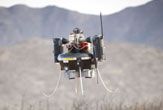Micro Air Vehicle On Patrol In Iraq

Honeywell's micro air vehicle (see photo), which uses a special fan propulsion system providing true vertical takeoff and landing capability, is now in use in Iraq by the US Army. This real-life drone aircraft has a variety of science-fictional ancestors that you might recognize.
The MAV is being used to check for roadside bombs and ambushes; it can carry regular day cameras, as well as thermal systems for night use. Streaming real-time video is sent to a ground station for evaluation by troops; the entire system can be carried in two backpacks.
The Micro Air Vehicle offers both "hover and stare" as well as "perch and stare" capabilities; it can hover at altitudes as high as 10,500 feet, or it can land and continue sending video. The MAV has performed well in urban environments as well as open field; it can even function in confined spaces. It's flight time is limited to the small amount of fuel it can carry; other unmanned air vehicles may stay aloft longer (see Like a Hawk, Robotic Plane Rides Thermals).
When I saw this thing maneuver (see Honeywell MAV video), I thought that the US Army was using Imperial Probe Droids. This well-known Star Wars technology uses repulsorlift engines to hover while its arms touch the ground to gather samples. Probe droids are autonomous robots that can be dispatched over interstellar distances to send back data and video.
UK readers may want to compare the Micro Air Vehicle with the flying golden Daleks from past seasons of Dr. Who (see photo). Once famed as a level-ground-based race of irritable extraterrestrial mutants integrated with impenetrable cases of pure dalekanium, Daleks were given thruster-powered flight after fans derided them for being unable to even climb stairs. (Other fans stated that, rather than climb stairs, Daleks would simply level the building.)
SF movie fans might also recall Michael Crichton's 1985 movie Runaway, about a special police group that specialized in dealing with robots gone out of control. In the film, a floater camera is used to gain more information about a hostage situation (see floater camera photos).
Read more about MAVs in the news at The Register and Defense Review; see also Honeywell's micro air vehicle page.
Sign up for the Live Science daily newsletter now
Get the world’s most fascinating discoveries delivered straight to your inbox.
(This Science Fiction in the News story used with permission from Technovelgy.com - where science meets fiction.)
Most Popular

